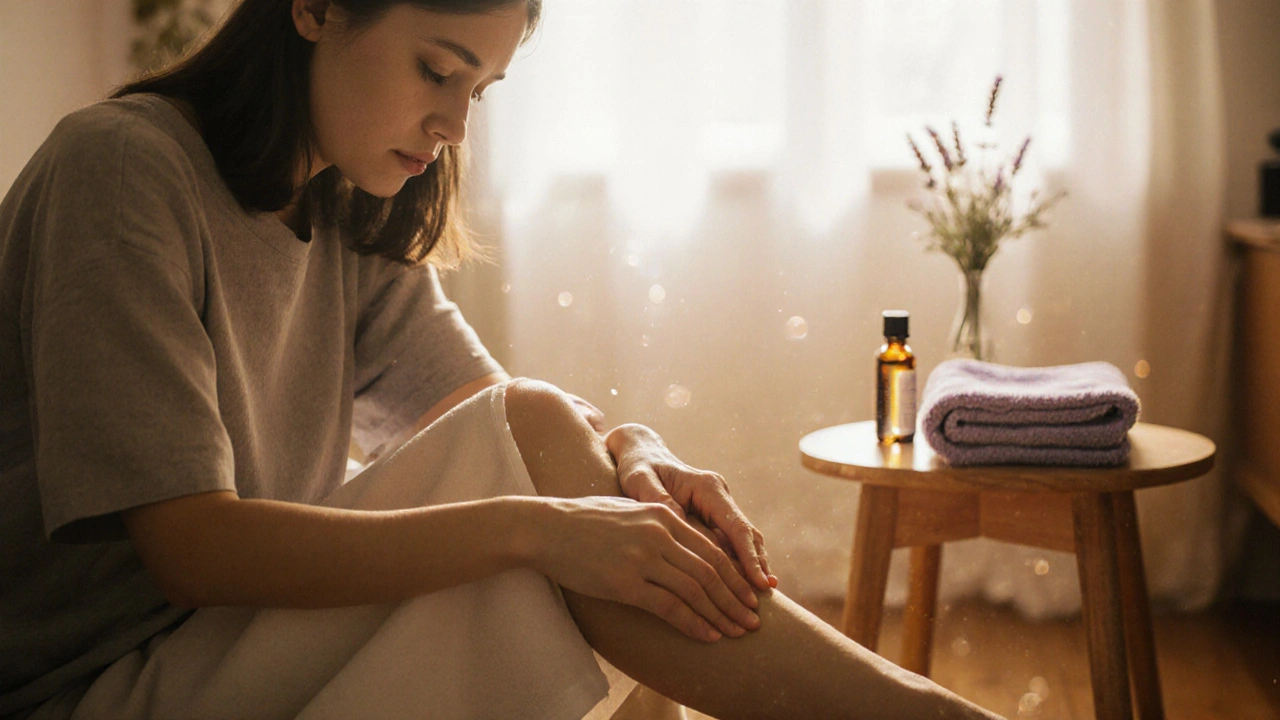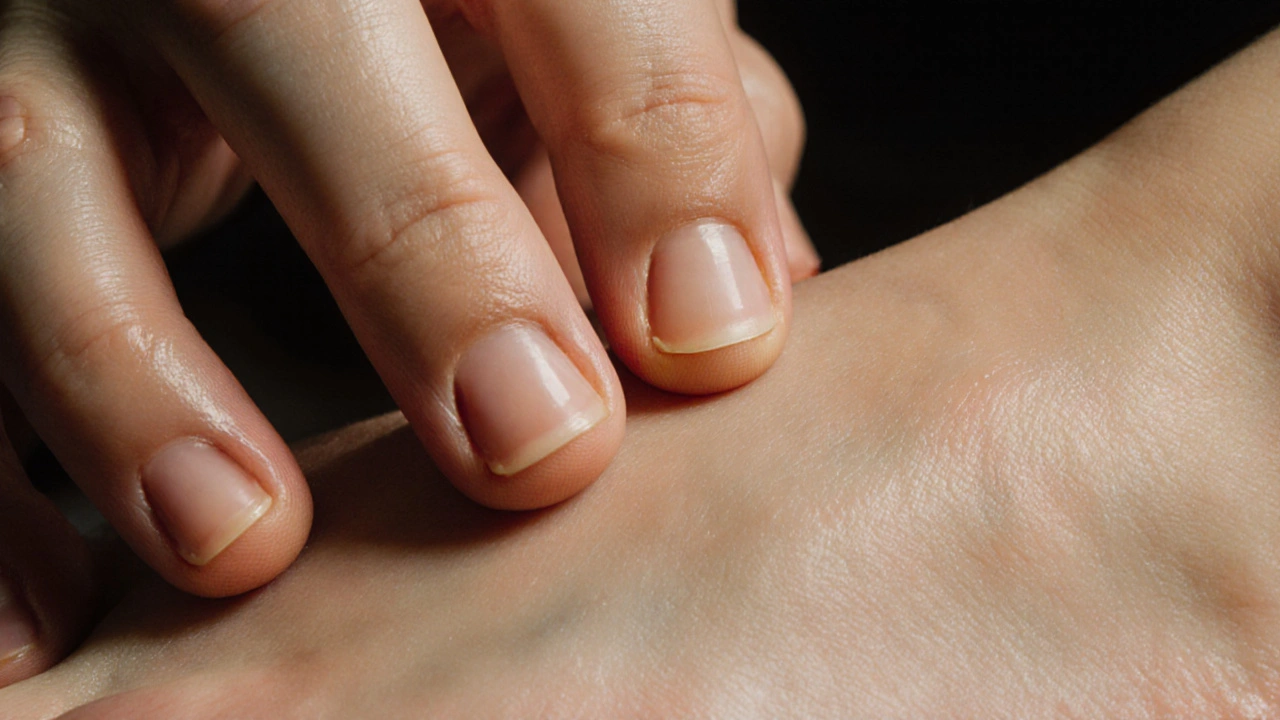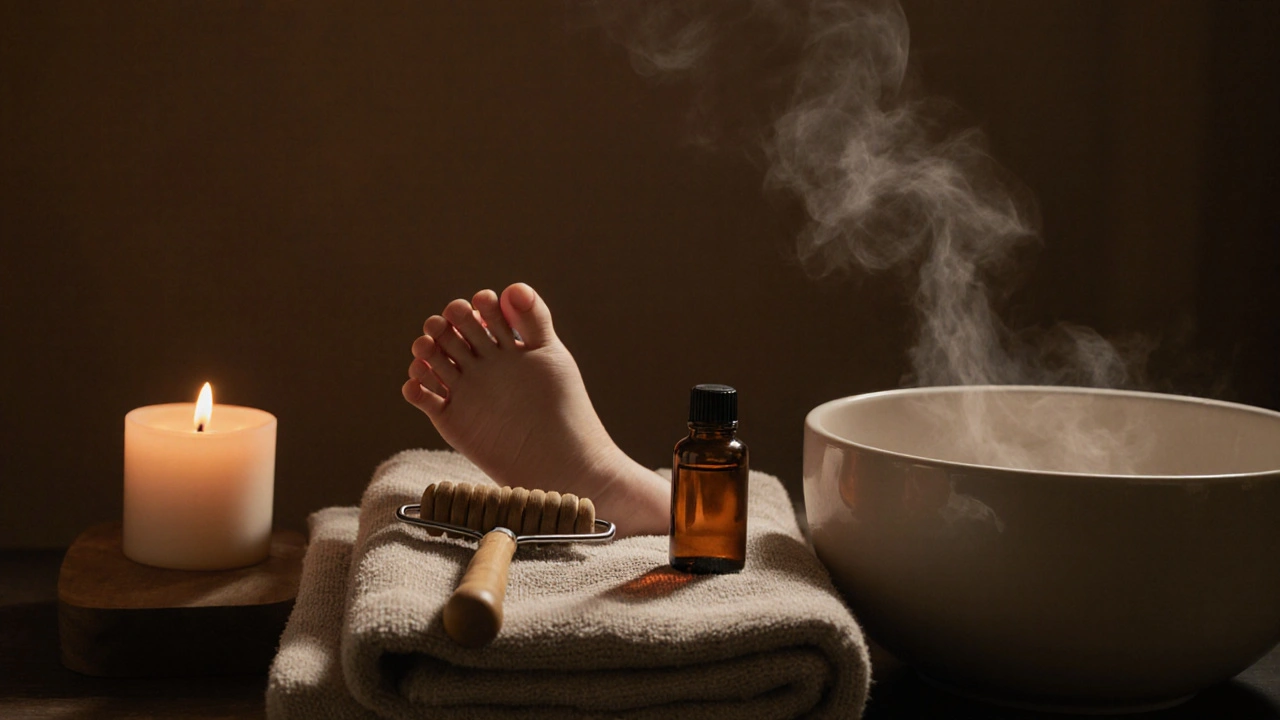
When was the last time you truly relaxed your feet? Not just kicked off your shoes after a long day, but let someone - or even yourself - gently work out the tension, pressure, and fatigue that’s built up over hours of standing, walking, or rushing? Foot massage isn’t just a luxury spa treat. It’s a simple, powerful way to reset your nervous system, melt away stress, and reconnect with your body. Think of it as a quiet conversation your feet have with your brain: "Hey, I’ve been carrying you all day. Can we slow down now?" And the answer? Yes. Always yes.
Foot massage isn’t new. Ancient civilizations from China to Egypt practiced some form of foot pressure and rubbing. In Traditional Chinese Medicine, foot massage was tied to meridians - energy pathways - that connect the feet to every major organ. Around 2500 BCE, tomb carvings in Egypt show scenes of foot and hand manipulation. By the 20th century, American physiotherapist William Fitzgerald developed "zone therapy," which later evolved into reflexology. Today, foot massage blends ancient wisdom with modern understanding of anatomy and nervous system responses. It’s not magic. It’s biology.
At its heart, foot massage uses pressure, kneading, and stretching to stimulate nerve endings in the soles, arches, and toes. These areas are densely packed with sensory receptors - more than any other part of the body. When you press or rub them, signals travel to the brain, triggering relaxation responses. It’s not about fixing problems; it’s about signaling safety. Your body hears the touch and thinks, "We’re not in danger right now." That’s when your heart rate slows, your breathing deepens, and cortisol levels drop. Even a five-minute session can shift your state from "on alert" to "calm down."
People often confuse foot massage with reflexology or pedicures. Here’s how they stack up:
| Practice | Key Feature | Primary Benefit |
|---|---|---|
| Foot Massage | General manipulation of foot muscles and tissues | Relaxes muscles, improves circulation, reduces tension |
| Reflexology | Pressure applied to specific points linked to organs | Believed to support organ function through nerve pathways |
| Pedicure | Cosmetic care: trimming, polishing, exfoliating | Improves appearance and hygiene of toenails and skin |
Foot massage is about comfort. Reflexology is about balance. Pedicures are about looks. You can get all three at once - but only foot massage gives you immediate, measurable stress relief.
Almost everyone. Office workers with achy feet after sitting all day? Yes. Parents on their feet from toddler chaos? Absolutely. Athletes recovering from training? Definitely. Even people with chronic pain conditions like plantar fasciitis find relief when massage is done gently and correctly. It’s especially helpful for those who feel disconnected from their bodies - the kind of people who don’t notice they’re clenching their jaw until their head hurts. Foot massage brings awareness back. No special skills needed. No equipment required. Just your hands, a bit of oil, and five minutes.
Studies from the National Institutes of Health suggest that regular foot massage lowers cortisol, the body’s main stress hormone. In one trial, participants who received just 10 minutes of foot massage three times a week reported feeling calmer, sleeping better, and reacting less sharply to daily stressors. Why? Because the soles of your feet are wired directly to the parasympathetic nervous system - the part that says, "It’s safe to rest." When you massage them, you’re flipping a switch in your brain from "fight or flight" to "rest and digest." You don’t need meditation apps or breathing exercises. Sometimes, all you need is your thumbs pressing into the ball of your foot.
Feet are your foundation. If they’re tight, stiff, or sore, everything above them suffers - knees, hips, even your posture. Regular foot massage improves circulation, reduces swelling, and loosens fascia (the connective tissue that wraps around muscles). This means better balance, less fatigue, and fewer aches. Nurses, teachers, and retail workers who massage their feet daily report fewer leg cramps and less lower back pain. It’s not a cure, but it’s a daily reset that keeps your body working the way it should.
There’s something deeply grounding about touching your own feet. In a world that’s always pushing us to do more, be more, feel more - foot massage is permission to do nothing. It’s a quiet act of self-care that says, "I matter." Many people who start massaging their feet regularly say they feel more centered, less anxious, and more present. It’s not just physical. It’s emotional. For those dealing with depression or burnout, it’s often the first small step back toward feeling alive in their own skin.
Here’s how foot massage fits into real life:
| Benefit | Description | Impact |
|---|---|---|
| Improved Sleep | Calms the nervous system before bed | More restful, deeper sleep |
| Reduced Headaches | Relieves tension linked to neck and shoulder stress | Fewer tension headaches |
| Lower Blood Pressure | Triggers relaxation response in blood vessels | Stable, healthier readings over time |
| Boosted Mood | Releases endorphins and reduces stress hormones | More positive outlook, less irritability |
You don’t need a spa. A quiet corner of your living room, a comfy chair, soft lighting, and a towel to wipe your feet afterward are enough. Add a candle, some calming music, or just the sound of rain outside. The goal isn’t perfection - it’s presence. Even doing it in your bedroom before bed works. The environment just needs to feel safe and still. If you’re getting a professional massage, expect a clean, warm room with a massage table or reclining chair. No loud music. No rushed movements. Just gentle, focused attention.
Here’s what happens in a typical session:
Each step takes about 30 seconds. Total time? 10 minutes. That’s it.
Everyone’s feet are different. If you’re sensitive to pressure, go lighter. If you’ve got tight muscles, spend more time on the arch. You can use a tennis ball under your foot while sitting at your desk. Or try a wooden foot roller for deeper pressure. Some people like heat - a warm towel wrapped around the feet before massaging helps. Others prefer cool peppermint oil for a refreshing tingle. There’s no right way. Only what feels right for you.
If you’re getting a massage from someone else, speak up. Say if it’s too hard, too soft, or if something hurts. You’re not being rude - you’re helping them help you. If you’re doing it yourself, check in with your body. Is your breathing still shallow? Are you still thinking about your to-do list? Gently bring your focus back to your hands and your feet. This isn’t a chore. It’s a ritual.

Keep a small bottle of massage oil or lotion near your bed or desk. A soft towel, a quiet space, and five minutes are all you need. If you’re doing it at night, dim the lights. If you’re doing it during lunch, close your eyes. You don’t need to be alone - but you do need to be present. Make it part of your routine, like brushing your teeth. Only better. Because your feet deserve it.
You don’t need fancy gadgets. But if you want to go deeper, try:
For professional care, look for licensed massage therapists with training in foot or reflexology techniques. Check their credentials through national associations like the American Massage Therapy Association.
Here’s a simple routine you can do at home:
Do this every night before bed. Or after work. Or whenever you feel your shoulders creeping up to your ears.
First-timers often think they need to be experts. You don’t. Start with 5 minutes. Use your fingers. It’s okay if it feels awkward. The goal isn’t perfection - it’s connection. If you’re doing it with a partner, take turns. One person massages while the other relaxes. No talking. Just touch. It’s surprisingly intimate. And it builds trust. After a few weeks, you’ll both look forward to it. It becomes your quiet time together.
You’ll likely feel warmth, tingling, or a deep sense of calm. Some people feel emotional - tears, laughter, or sudden relaxation. That’s normal. Your feet hold a lot of stored stress. When you release it, your body responds. You might notice your breathing slows, your jaw unclenches, or your shoulders drop. It’s not a miracle cure, but it’s one of the most reliable ways to reset your nervous system in under 10 minutes. Don’t expect instant pain relief if you have chronic issues - but you will feel lighter, calmer, and more grounded.
During a session, your therapist or partner applies pressure using thumbs, fingers, or tools to stimulate nerve endings, muscles, and connective tissues. Blood flow increases, tension releases, and your brain receives signals that you’re safe. You might hear a few pops or feel slight discomfort in tight areas - that’s just fascia releasing. But it shouldn’t hurt. If it does, speak up. A good session leaves you feeling relaxed, not sore. Most people fall asleep during the last few minutes - and that’s the best compliment you can give.
Foot massage works on muscles and soft tissue to relax the body. Reflexology targets specific points on the feet believed to correspond to organs and systems - like the liver, heart, or lungs. While reflexology is based on traditional energy maps, foot massage is grounded in anatomy and physiology. You can do both, but if your goal is stress relief, foot massage is faster and more direct. Reflexology can feel more abstract. Foot massage feels like a hug for your feet.
The method is simple: apply steady, rhythmic pressure using your thumbs, fingers, or tools. Start with light strokes to warm the skin, then increase pressure on areas that feel tight. Focus on the arch, ball of the foot, and heel - these are the most sensitive and beneficial zones. Use circular motions, long strokes, and gentle stretching of the toes. Don’t rush. Spend at least 3-5 minutes per foot. Consistency matters more than intensity. Even 5 minutes a day makes a difference.
If you’re seeing a professional, ask about their training. Look for certifications from recognized bodies like the American Massage Therapy Association or the International Institute of Reflexology. Avoid places that promise "miracle cures" or claim foot massage can cure diabetes or cancer. That’s not science - it’s scam. A good therapist will ask about your health, not push you into expensive packages.
Keep it clean. Wash your feet before massaging. Use clean towels. Don’t massage over open wounds, bruises, or infections. If you have diabetes, neuropathy, or circulatory issues, go easy. Ask your doctor first. Always use a lubricant - dry skin rubbing can cause irritation. And never force a joint or stretch too hard. Your feet are delicate. Treat them like the precious foundation they are.
| Practice | Purpose | Example |
|---|---|---|
| Wash feet before | Prevent infection | Use warm water and mild soap |
| Use oil or lotion | Reduce friction | Coconut, almond, or jojoba oil |
| Check for injuries | Avoid aggravating damage | Don’t massage over blisters or cuts |
| Listen to your body | Prevent overstimulation | Stop if you feel sharp pain |
Even with a partner, it’s okay to say, "That’s too much," or "I’d prefer lighter pressure." You don’t owe anyone your comfort. If you’re uncomfortable with touch, start with self-massage. Build your own relationship with your body first. There’s no rush. This is your space.
Avoid foot massage if you have: deep vein thrombosis, active infections, severe osteoporosis, or recent foot surgery. Pregnant women should consult their provider - some pressure points can stimulate contractions. People with diabetes should avoid excessive pressure on the soles due to reduced sensation. When in doubt, ask your doctor. It’s not about avoiding foot massage - it’s about doing it safely.

Pair foot massage with deep breathing. Inhale for four counts, hold for four, exhale for six. Or listen to calming music - nature sounds work best. Try doing it after a warm bath. Or before meditation. The more you link it to other relaxing habits, the more your brain will associate it with calm. You’re not just massaging your feet - you’re training your nervous system to relax on cue.
Doing it alone? Great. You’re practicing self-love. Doing it with someone? Even better. It’s a quiet way to connect without words. Try a weekly "foot night" with your partner, roommate, or parent. No phones. No talking. Just touch. You’ll be surprised how much closeness you build.
A tennis ball under your foot while sitting at your desk is a game-changer. Roll it slowly from heel to toe. A wooden foot roller gives deeper pressure. A heated foot bath before massaging? Luxury. But none of these are required. Your hands are the best tool you’ve got.
One session helps. Daily sessions transform. Think of it like brushing your teeth. You don’t do it once a month and expect perfect gums. Do it every day, even for five minutes. Over time, your feet will feel lighter, your steps will feel easier, and your stress will feel quieter. It’s not about fixing something broken. It’s about maintaining what’s already whole.
Look for licensed massage therapists with foot or reflexology training. Check reviews on trusted platforms. Ask if they’ve worked with clients who have your condition - like plantar fasciitis or arthritis. Avoid places that pressure you into packages or promise "cures." A good therapist will listen, not sell.
YouTube has excellent free tutorials from certified therapists. Look for channels like "The Foot Health Channel" or "Massage Therapy Academy." Reddit’s r/footmassage has real stories and tips from people who do it daily. These aren’t ads - they’re communities of people who care about their feet.
Foot massage is widely accepted in most cultures. But in some places, touching feet is considered disrespectful. If you’re in a shared space or with someone from a different background, ask first. Always respect personal boundaries - even when offering help.
Books like "The Reflexology Handbook" by Christine Uhl or "Foot Reflexology: A Complete Guide" by Barbara Bowers offer clear, practical insights. Online courses from the International Institute of Reflexology are affordable and well-reviewed. Start small. Learn one technique. Master it. Then add another.
Foot massage doesn’t promise to fix your life. But it gives you a daily pause - a moment where you stop doing and start feeling. In a world that never stops demanding more, that’s revolutionary. It’s not about spending money or time. It’s about showing up for yourself, one foot at a time.
Start tonight. Take five minutes. Wash your feet. Use your thumbs. Breathe. Notice the difference. If it feels good, do it again tomorrow. If it doesn’t, that’s okay too. You’ve still given yourself the gift of attention.
Tried foot massage? Share your experience in the comments - what worked, what didn’t, how you felt afterward. Follow this blog for more simple, science-backed ways to feel better without buying anything. Explore foot massage and let us know how it goes.
Some links may be affiliate links, but all recommendations are based on research and quality.
Word count: 1,728